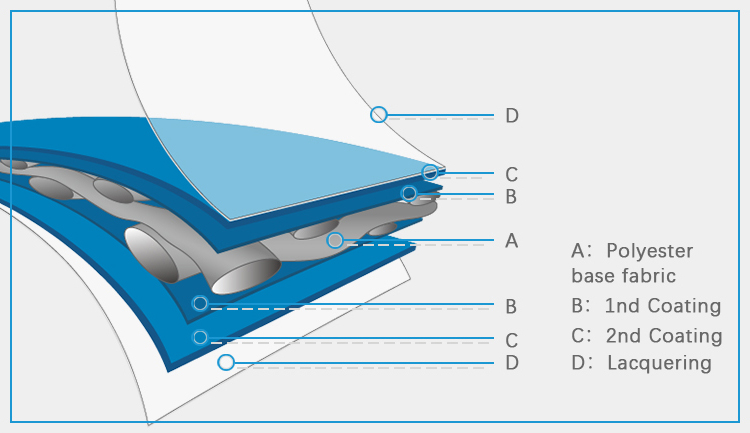Product Categories
Industrial fabric popular science series Two---Coating and film


Coated fabric is a new type of material that has developed extremely rapidly in recent years. It is a composite material that integrates structural mechanics, material science and design, and is a new economic growth point for the textile industry. Polyvinyl chloride (PVC) has good aging resistance and is a cost-effective coating material.
At present, there are three types of coating fabric manufacturing processes, namely laminating method, calendering method and coating method. The laminating method is a processing method in which the upper and lower layers of the formed PVC film are heated and laminated with the middle base fabric layer under the pressure of a hot roller; The calendering method is a processing method in which various raw materials such as PVC powder and liquid plasticizer are fully stirred and bonded to the base fabric under the pressure of a high temperature hot roller. The coating method is to evenly coat the liquid PVC slurry on the front and back sides of the base fabric with a scraper, dry and plasticize it to make it completely integrated into a whole, and then cool and shape. The products produced by the laminating process and the calendering process have poor peel strength, while the products produced by the coating process can be added with a certain adhesive, and the products have better peel strength. The comparison is as follows:
PVC laminated fabric | PVC semi coated fabric | ||
Composition | base fabric and coating | base fabric and a PVC film | base fabric,coating and PVC film |
Coating | The main component of the coating | PVC film | PVC paste resin + PVC film |
Craft | The paste-like PVC slurry poured | The PVC film attached to | first sizing, |
Advantage | high adhesion | high production efficiency | high production efficiency |
Disadvantage | poor air tightness | short service life | short service life |
Service life | long | short | short |
production efficiency | low | high | high |
Air-tight | poor | good | good |
Style | Both the front and back are relatively flat | The front is flat | The front is flat |
The addition of plasticizers can reduce the force between PVC molecular chains and reduce the glass transition temperature, flow temperature and melting point of the crystallites contained in the PVC plastic. The plasticizer can improve the plasticity of the resin, make the product soft and have good low temperature resistance.
Because the material contains plasticizers, it is susceptible to mold attack. The anti-mold agent is added to kill the mold and prevent the PVC material from being mildewed and rotten.
Fillers are solid additives used to improve the performance of composite materials and reduce costs,its functions are:
① reduce the shrinkage of molded parts, improve the dimensional stability, surface finish, and smoothness of the product;
② effectively adjust the resin viscosity;
③ It can meet different performance requirements and improve wear resistance. Most fillers can improve the impact strength and compressive strength of the material, but cannot increase the tensile strength;
④ Improve the coloring effect of the pigment.
PVC coating/polyester fabric is mainly PVC coated (or laminated) on polyester fabric to make the fabric have color, strength and water resistance. PVC/polyester fabric can be welded frequently. Microwave can be used when welding. Toughening agents are generally added to PVC. Microwave can remove the toughening agent in the weld, and the strength of the weld is better than that of PVC/polyester fabric itself. PVC/polyester fabric has the advantage of low cost because of its cheap materials, convenient transportation and storage, and easy processing and construction.
You may also like
- 24' X 28' (8' Drop & Flap) Lightweight Flatbed Trailer Lumber Tarp - 14 Oz. Black Tarp
- PVC knife coating fabric raw material for truck cover
- 24' X 28' (8' Drop & Flap) Lightweight Flatbed Trailer Lumber Tarp - 14 Oz. Black Tarp
- Heavy Duty Shade Netting Mesh Dump Truck Tarp
- Clear Glass Tarpaulin Pergola Sides Plastic Awning Transparent Waterproof Terrace PVC Curtains
- 750G Keder Tent Material Black
- Heavy Duty 14oz PVC Vinyl Tarpaulin For Flatbed Lumber Tarps
- Waterproof Window Side Curtain PVC Tarp Clear PVC Tarpaulin for Tent
- PVC Tarpaulin Wateproof Fabric Flatbed Lumber Tarp For Heavy Duty Truck
- Truck Flatbed Trailer Tarps Lightweight Lumber Tarp 24x27 (8' drop)
Others also viewed
- How To Choose The Best PVC Tarpaulin Outside?
- How to clean pvc tarp
- PVC waterproof tarpaulin scratches and waterproof treatment method
- Advantages of Clear PVC Vinyl Tarps
- Why Are Tarps So Expensive? Are They Expensive To Buy And Own?
- Five characteristics of pvc coated fabric
- Which Fabric Is Best For Roller Blinds?
- Waterproof canvas detailed introduction
- Why PVC material tarpaulin is so popular
- Professional Q&A on the application of pvc fabirc raw materials---Ms. Hallen, sales manager of jumtarps